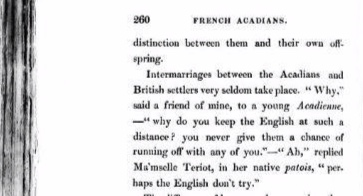“Semi-Indians” residing at Clare, NS 1830
This excerpt describes a group of “Semi-Indians” residing at Clare, NS who are not considered equal to “White” Acadians. This was a primary observation made during his tour of Nova Scotia in the mid-1820s. Captain Moorsom states the following in this passage:
“A few families of semi-Indian extraction are to be found in this settlement: their origin must be referred to the commencement of the eighteenth century, when the invasion and partial subjugation of Nova Scotia by the British forces from New England, united the Acadian-French and Indians in common cause against the intruders, and subsequently forced many of the former to take refuge among the fastnesses of their savage allies. These families are looked upon as rather without the pale of social brotherhood; but their habits do not differ from those of their neighbours, and it is probable they will gradually become blended with the general mass of the community.”
It is important to note that Captain Moorsom provides an approximate time period when the inter-mixing with the First Nations people occurred in the ancestry of these “Semi-Indians.”
Captain Moorsom also states the following:
“Intermarriages between the Acadians and British settlers very seldom take place. “Why,” said a friend of mine, to a young Acadienne, - “why do you keep the English at such a distance? you never give them a chance of running off with any of you.” – “Ah,” replied Ma’mselle Teriot, in her native patois, “perhaps the English don’t try.””
This last passage is important because it demonstrates that very little outside “blood” was added to the “genepool” of the Acadians of the Clare/Baie-Sainte-Marie region overall. So when taken in collaboration with Père Jean-Mandé Sigogne’s later-discussed writings, which were from the same time period as those of Captain William Moorsom’s writings, one can conclude that the “Sang-Mêlés (Mixed-Bloods)” of the region most likely married among themselves.
One final passage from Captain Moorsom’s writing states the following:
“The Acadians of Tusket resemble their brethren of Clare:”
So why is this sentence so important? Well, Captain William Moorsom clearly didn’t see any real difference between the Acadian communities of Southwest Nova Scotia overall. There were obviously similar Acadian communities in the region. Why does this matter?
Well, this matters because Père Jean-Mandé Sigogne’s November 05, 1826 sermon entitled, “Pénitence Imposée” (which I will discuss below) was given to the parishioners of the parish of Sainte-Anne-du-Ruisseau in Argyle, Yarmouth County, Nova Scotia. The Acadians of Tusket, Nova Scotia attended the parish of Sainte-Anne-du-Ruisseau! So, if the Acadians of Tusket “resemble(d) their brethren of Clare,” then the fact that the Acadians of Clare/Baie-Sainte-Marie rarely intermarried with “English,” most likely applied to the Acadians of the Tusket region as well.
Clearly the intense and widespread prejudice and hatred directed toward “Sang-Mêlé (“Mixed-Blood”)” families by the “Blanc (“White”)” Acadians in Clare mirrored the attitude of the “Blanc (White)” Acadians of Tusket toward the “Sang-Mêlé (Mixed-Blood)” families of Clare. So why wouldn’t the fact that very little intermarriage between the Acadians of Clare and the “English” of the area not mirror the marriage practices of the Acadians of Tusket as well?

















